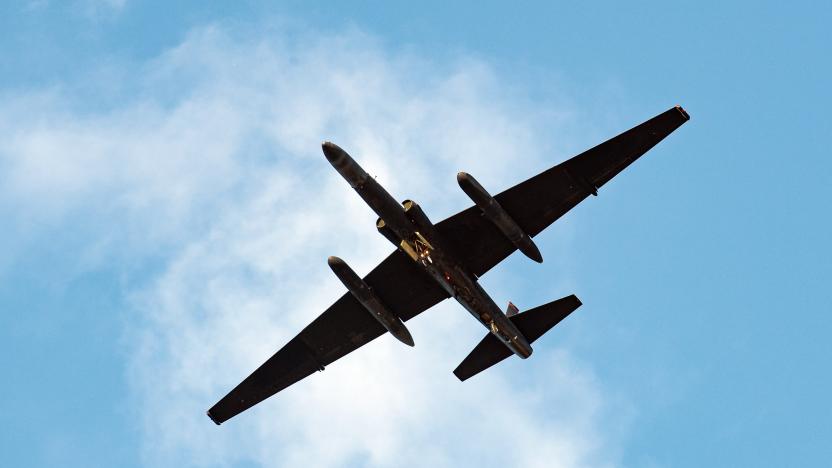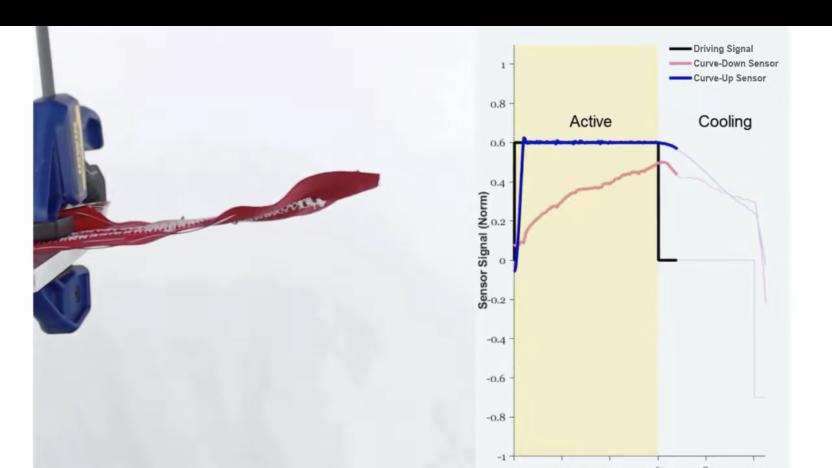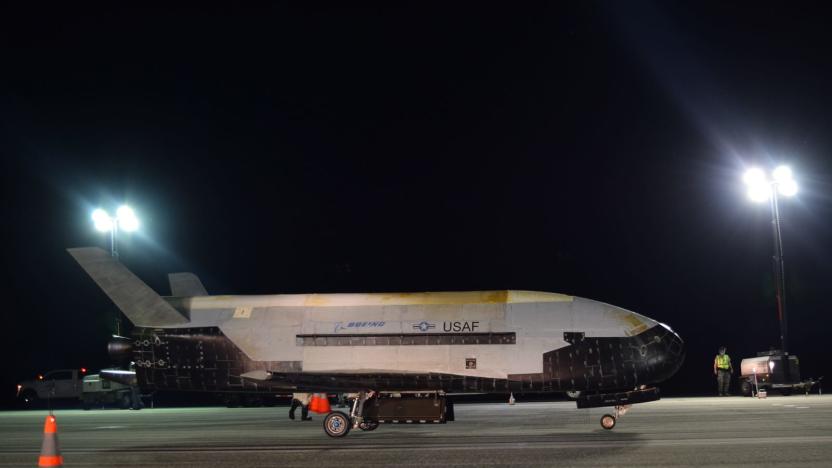us air force
Latest

AI controlled a US military aircraft for the first time
AI has controlled a US military aircraft for the first time, serving as a co-pilot aboard a U-2 spy plane in a milestone test for the Air Force.

Yale's smart robotic fabric is as flexible as you need it to be
Now a research team out of Yale University has taken the technology one step further with the invention of smart, robotic fabric that can change its shape and stiffness on the fly. The team, led by Dr. Rebecca Kramer-Bottiglio, spun epoxy into fibers that can vary their stiffness thanks to the particles of Field’s metal embedded within them. Field’s metal is novel in that it liquefies at very low temperatures.

Nearly the whole US military has banned TikTok
When the Army, Marines and Navy all put the kibosh on TikTok, you knew it was just a matter of time before other US military branches followed suit -- and sure enough, they have. The Air Force and Coast Guard have confirmed to the Wall Street Journal that they no longer allow TikTok on government-issued devices. It's not yet clear that the ban is truly comprehensive (the recently established Space Force hasn't weighed in), but it effectively leaves no 'safe' space for TikTok on military hardware.

Air Force's X-37B space plane lands after record 780 days in orbit
There was no doubt that the US Air Force's X-37B was going to break its own record for time spent in orbit, but it's now clear by how much. The mysterious Boeing-made space plane has landed at Kennedy Space Center after 780 days in orbit, comfortably surpassing the earlier record of 717 days, 20 hours and 42 minutes. That's more than three times the 240 days originally expected from the reusable vehicle, which just finished its fifth mission.

SpaceX sues over 'wrongly awarded' Air Force rocket contracts
To say that SpaceX was unhappy with losing out on the US Air Force's rocket development contracts would be an understatement. The company has sued the US government under claims that the Air Force "wrongly awarded" contracts to Blue Origin, Northrop Grumman and United Launch Alliance. The military branch handed out offers to the competition despite their "unproven rockets" and "unstated metrics," while allegedly ignoring SpaceX's own real-world record. The company had completed numerous missions with its Falcon rockets, according to the lawsuit, but was deemed "highest risk" because of its largely untested Starship.

US Air Force successfully shoots down multiple missiles with a laser
The US Air Force just edged closer to its goal of outfitting aircraft with laser weapons. Testers at the White Sands Missile Range have successfully shot down multiple air-launched missiles using the Self-Protect High Energy Laser Demonstrator (SHiELD), proving that it can hold up under intense situations. While SHiELD is currently a ground-based behemoth (see below), the finished technology should be portable and rugged enough to be used aboard aircraft.

US Air Force and DARPA team up on hypersonic weapons
"What do we want to do with this technology? We want to weaponize it." The US Air Force told Military.com it's planning to build on the X-51A WaveRider's "scramjet" (supersonic ramjet) trials to develop hypersonic weapons that compress air by sheer velocity. During tests in 2013, the WaveRider set a record by flying at Mach 5.1 (3,400mph) for over three minutes after it was dropped from a B-2H bomber and accelerated by a rocket. While those trials were just a proof-of-concept, the Air Force has teamed up with DARPA take the technology to the next level.

US Air Force is saving huge money with iPads
The US Air Force has opened up about how the iPad will help it realize over US$50 million in savings over the next 10 years, as 18,000 iPads replace flight manuals. In an interview with The Street, US Air Force Major Brian Moritz described the huge drop in costs. "We're saving about 90 pounds of paper per aircraft and limiting the need for each crew member to carry a 30- to 40-pound paper pile [of flight manuals]. It adds up to quite a lot of weight in paper." The Street notes that specific weight savings varies across aircraft. For instance, the iPads eliminate 250 pounds from a four-person C-17, and up to 490 pounds in a C-5 with a crew of 10. In a related story from the civilian world, American Airlines recently described how its adoption of iPads has reduced the number of pilots reporting back injuries. American's VP of Airline Operations, Patrick O'Keeffe recently noted at the Tablet Strategy Conference in New York City, "We've reduced the single biggest source of pilot injuries, carrying those packs. And we are now able to save $1 million in fuel costs and stop printing all the page revisions."

Boeing tests microwave missile that knocks out electronics, represents our worst nightmare (video)
Forget bombs or the robopocalypse. In our minds, the most fearsome weapon is the one that disables our gadgets. That's what makes Boeing's newly tested Counter-electronics High-powered Microwave Advanced Missile Project (CHAMP) scarier than most projectiles. The missile bombards targets underneath with microwaves that shut down computers, power systems and just about anything electrical in their path. Thankfully, CHAMP's invisible payload arrives in discrete bursts and arguably makes it the world's most advanced (and likely expensive) non-lethal weapon: the prototype can target multiple individual buildings without ever having to detonate and hurt someone. Boeing is still developing CHAMP in a multi-year program and doesn't have guarantees that it will become military ordnance, which gives us enough time to accept that saving lives is far, far more important than the risk we'll have to stop fiddling with our technology.

MIT's real-time indoor mapping system uses Kinect, lasers to aid rescue workers
We've seen the Kinect put to use to help you find your groceries, but the sensor's image processing capabilities have some more safety-minded applications as well. The fine minds at MIT combined the Kinect with a laser range finder and a laptop to create a real-time mapping rig for firefighters and other rescue workers. The prototype, called SLAM (for Simultaneous Localization and Mapping) received funding from the US Air Force and the Office of Naval Research, and it stands out among other indoor mapping systems for its focus on human (rather than robot) use and its ability to produce maps without the aid of any outside information, thanks to an on-board processor.

NASA's X-48C hybrid wing-body plane completes first test flight
After planting a rover firmly on Mars' surface and testing a new methane-fueled lander, NASA has squeezed in the first test flight of its X-48C hybrid wing-body aircraft. Thanks to its design, which combines those of flying-wing and conventional planes, the X-48 could offer 20 to 30 percent more fuel-efficiency, greater fuel capacity and a quieter ride in its final form than traditional craft. The finished model has a projected range of 11,000 nautical miles and a 240-foot wingspan. As an 8.5 percent scale of the full-sized airplane, the remotely piloted prototype weighs in at 500 pounds with a 20-foot wingspan. During the test, it successfully took to the skies for nine minutes and peaked at an altitude of 5,500 feet -- though it's capable of soaring for 35 minutes and climbing nearly twice as high. Another version of the craft (likely with a human behind the flight stick) is estimated to be at least four years down the road, and the final model isn't expected to arrive for another decade.

Lockheed Martin F-35 Lightning II stealth fighter cockpit demonstrator hands-on (video)
We spend hundreds of hours on board a variety of airplanes each year, most often en-route to a trade show or product launch event, but occasionally we have a rare opportunity to hop on board military aircraft, to test out unrelated products, or, even more unusually, to take a seat behind the yoke. Sadly that's not what we're doing today -- well, not exactly. We are taking a closer look at the F-35 fighter jet at Lockheed Martin's Fighter Demonstration Center just outside our nation's capital, but, being in the middle of a corporate complex, there's no actual Lightning II on hand. We were able to take a simulated ride, however -- this isn't your ordinary 4D sickness-inducing amusement park thrill. The F-35 is by far the most advanced Lockheed jet to date, with updated radar, all-internal weapons, improved tracking systems, 360-degree infrared coverage with a visor readout, and a full-stealth design, not to mention the incredibly capable glass cockpit powered by more than 9.3 million lines of software code, and an overall smoother experience for pilots that could end up spending shifts of 12 hours or longer in flight. The F-35 has already seen plenty of field time in the US, with more than 500 flights already in 2012, and it's set to make its way to the UK armed forces next week and the Netherlands later this year, but while the aircraft is quite familiar to the pilots tasked with flying it, the public hasn't had an opportunity to experience Lockheed's latest airborne warrior. We flew a simulated mission within a grounded duplicate of the flyable F-35 cockpit, and the capabilities and improvements are quite clear -- you definitely don't want to encounter an F-35 from a previous-generation aircraft. The dual 8 x 10-inch touch-enabled displays combine to give you 8 x 20 inches of real estate, with dedicated modules for the weapons systems, targeting, and navigation easily accessible -- you can also move them to different panels depending on your current objective. A pair of joysticks at the left and right side provide direct access, letting you move a cursor to track enemy crafts or ground-based targets as well, and a very slick heads-up-display mounted in the helmet provides infrared mapping and instrument readouts. Overall, it seems to be an incredibly powerful system. Unfortunately, the mock-up on display here isn't accessible to the public, but you can join us for a behind-the-scenes look just after the break.%Gallery-160208%

X-37B finally touches down, completing its not-so-secret classified mission (video)
After more than a year of circling the globe, the US Air Force's X-37B has finally touched down at Vandenberg Air Force Base in California. The unmanned, reusable space plane spent 469 days in orbit, performing a number of experiments (many of which are classified) before finally ending its lengthy run Saturday. What exactly the military has learned from the extended orbital excursion is unclear, but, like the Mars rovers before it, the X-37B turned out to be far more robust than many had anticipated. Its mission was originally intended to last just nine months, but its operators managed to milk about six more months out of the craft. While we wait to find out what the next step is, enjoy the video of it landing after the break.

Happy Biiiirthday Mr. USAF X-37B Robot Space Plane
The X-37B was only meant to stay up in space for a gestational nine months, but a full year has now passed since launch and the US Air Force apparently has little interest in bringing its baby home. On the contrary: according to Space.com, the plan is to send up another unmanned space plane to keep the X-37B company on its [CLASSIFIED] missions. Whatever it's getting up to in that airless playground, it must be doing something right. Air Force Lt. Col. Tom McIntyre says the craft is "setting the standard for a reusable space plane and, on this one-year orbital milestone, has returned great value on the experimental investment." Which is a fine way of saying [STILL CLASSIFIED].

Next-generation GPS satellite inches closer to space, countdown begins to 2014
Kvetching about your PND's inability to get a proper lock could soon become a thing of the past, thanks in large part to a fresh breed of GPS satellites designed by the whiz-kids at Lockheed Martin. The program -- which is estimated to eventually cost around $5.5 billion to complete -- is set to hit its prototype phase by 2014, with a pathfinder being recently delivered to the same Colorado facility that we toured earlier this month. The Block III prototype (more accurately known as the GPS III Non-Flight Satellite Testbed), won't actually be hurtled into space, but the Air Force is slated to launch 32 of the final versions over the next few years. The aforementioned birds should improve power, reliability and accuracy, while also promising to be "harder for enemies to jam and easier for receivers to tune in, especially in urban canyons or under thick tree canopies." Moreover, they're expected to enable both denizens and military users to grab a position within three feet, compared to ten feet using today's technology. In other news, they're sure to cause LightSquared all sorts of new headaches.

This giant military spy blimp is really hard to miss
What's this spy blimp doing next to an 18-wheeler? We're not entirely sure, but it's certainly not being subtle about it. This jumbo-sized floater, codenamed "Blue Devil Block 2," measures some 370 feet in length and comprises a whopping 1.4 million cubic feet. Originally inflated in September, the definitely-not-blue Blue Devil took flight for the first time last week in North Carolina and, if all goes to plan, should head to Afghanistan by the middle of next year. The Air Force says the blimp will hover above the country for five days at a time, collecting surveillance data from 20,000 feet above the ground and transmitting its findings to US intelligence officers on the ground, via laser. When that's taken care of, it'll be used to make the biggest omelette ever.

Laser steering system uses liquid crystal to destroy the enemy on the cheap (video)
It might look like a poor man's game of Pong now, but a new laser steering system coming out of North Carolina State University could make blowing things up Star Wars-style cheaper and more efficient. The setup enlists a series of "polarization gratings" through which a laser beam passes. Each of these gratings, made of liquid crystal applied to a plate of glass, are configured to redirect the light in a particular direction, thus simply steering the laser beam without significantly decreasing its power -- with each grating comes a new "steerable" angle. The system's creators point out its not only hyper accurate, but also less expensive than existing arrangements due to the use of liquid crystal. Apparently the US Air Force is already using the stuff, but don't expect them to go all Death Star anytime soon.

BPG Werks DTV Shredder test-ride (video)
We first heard of the Shredder back in September, a crazy, treaded contraption that looked fit to appear in the next Starship Troopers film -- or maybe a TMNT reboot at least. It's the product of the overactive mind of Ben Gulak, the guy behind the Uno transforming and self-balancing motorcycle that we saw at CES. When Ben showed us some videos of the DTV Shredder at the show we knew we had to ride it, and so we did, hitting the sand in New Mexico and managing to come away from the experience unharmed and only a little dehydrated. Come on in to check out our experience on both the consumer-friendly Sport and rather brawnier Military edition, both of which could be in production by the end of the year. %Gallery-122305%

SA Photonics high-res digital night vision system makes you look like Hello Kitty's cyborg cousin
Given, it might make you look like the love child of Robocop and a cartoon kitten, but SA Photonics' High Resolution Night Vision System (HRNVS) could mean smoother night flights for the US military. The light weight head mounted display couples high resolution imagery and an impressive 82.5 degree field of vision -- previous devices offered a range of only 40 degrees. What's more, it provides clearer peripheral vision, virtually non-existent halo effects, digital image enhancement, and night vision recording. The headset was designed in collaboration with the US Army and the Air Force Research Laboratory, which means these robo Sanrio helmets might actually get some play. Full PR after the break.

US Air Force enlists super blimp for Blue Devil surveillance initiative
Way back in September 2009, we reported on an omnipotent war blimp from Lockheed Martin, now it looks like a similar dirigible could be hovering 20,000 feet above Afghanistan by this fall. (It's not clear whether or not the two blimps are one and the same, but Lockheed's craft was slated for an Afghan debut in 2011.) As part of the $211 million Blue Devil initiative, the US Air Force plans to pack the bloated beast -- which sports seven times the carrying capacity of the Goodyear blimp -- with up to a dozen interchangeable sensors and a supercomputer for processing data. It will then hover for stints as long as a week, collecting, assessing, and relaying important surveillance data to ground troops in a matter of seconds. It's a tall order, but Air Force officials hope that an on-board wide-area airborne surveillance system (WAAS), which uses 96 cameras to generate nearly 275TB of data every hour, and a supercomputer hosting the equivalent of 2,000 single-core servers will fit the bill. The aircraft isn't complete quite yet, but barring unforeseen obstacles, like a run-in with a giant needle, it should be up in the air starting October 15th. For more on Blue Devil check out our links below.












